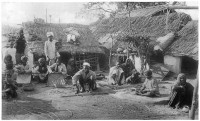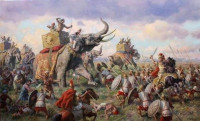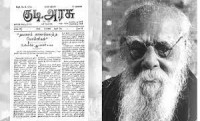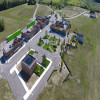Iyothee Thass and the Resurgence of Tamil Buddhism
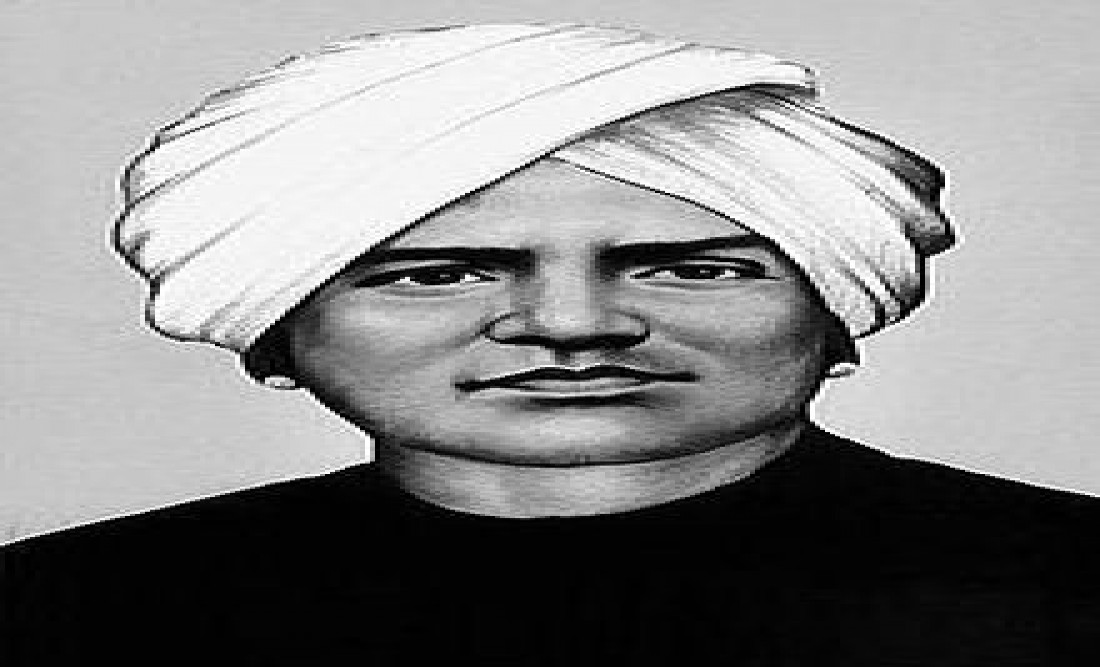
Pandit Iyothee Thass (1845–1914) was born in a Dalit family in Royapettah, Chennai. He was a doctor of Siddha system and a well-educated Tamil scholar. He had proficiency in traditional knowledge of astrology and palm-leaf manuscript study. In 1870, Iyothee Thass founded the Adhvaidhananda Sabha (considered his first institution-building activity) in Uthagamandalam, where he was raised. In 1891 he founded the organization called Dravida Mahajan Sabha and on 01 December 1891 he organized the first conference of the assembly at Ooty in Nilgiris district. Ten resolutions were passed in that conference in which criminal law acts to punish those who humiliate untouchables by calling them pariahs, creation of separate schools and provision of scholarships for matriculation education to untouchable students; The system of employment for educated untouchables and the system of representation for untouchables in district and municipal boards were included (Tamil, 14 October 1908).
These resolutions were sent to the Indian National Congress and the Mohammedan Committee on 21 December 1891. In 1896 the respected John Ratnam and Iyothee Thass jointly started a magazine Dravida Pandian. Another important information is that in 1882 the respected John Ratnam and Iyothee Thass started a movement called Dravida Kazhagam (G. Aloysius, Nationalism without a Nation in India, Oxford, 2000). However, this fact was hidden, as a result of which Iyothee Thass is not remembered today as a pioneer of the Dravidian movement or the anti-Brahmin movement.
Return to buddhism
Pandit Iyothee Thass encouraged the Dalits to embrace Buddhism for the abolition of the caste system. For this he created an alternate history with the help of Tamil literature and folk traditions of Tamil. He proved that the untouchables were Buddhist in origin and that untouchability was imposed on them because they opposed the orthodox traditions propounded by the Brahmins. Thass claimed that Buddhism was the first anti-Brahmin movement in Indian history. So he called upon the Dalits to return to their original religion, Buddhism.
In 1898, Iyothee Thass traveled to Sri Lanka with Krishnaswamy, the headmaster of the Panchama school, and converted to Buddhism there. According to The Theosophist (monthly magazine published from Adyar, Chennai of the Theosophical Society):
Pandit C. Iyothee Thass was one of the two gentlemen who was taken to Ceylon with Colonel Alcott in 1898 as a representative of the Panchama community of Madras. Both were incorporated into Buddhism by the High Bishop Sumangala. Thus in the history of the unfortunate Panchama people (Dalits) of South India
A new era had begun
The question of the origin and religious origin of the alien people of South India was so important that was determined to bring him in contact with the High Bishop Sumangala. If it is proved that they were of Buddhist origin, their community can be brought under close contact and supervision of the Buddhists of Ceylon (Theosophist Magazine, April–June 1914, p. no. 315).
Branches of the Sakya Buddhist society were established not only in Tirupattur and Vellore in the Madras Presidency, but also across the seas in Natal, Rangoon and Sri Lanka in South Africa. It is worth mentioning that there was a migration of Dalits as laborers here. Similarly, branches of Sakya Buddhist society were established at other places such as Champion Reef, Marikuppam and the Kolar Gold Fields near Bangalore, which were part of the then princely state of Mysore, where Dalits settled as mine-workers. The exploited people saw the colonial rule as an opportunity to come out of caste-exploitation. He did not only want reforms, but he worked for the eradication of caste by uprooting Hindu supremacy by returning to his original religion Buddhism.
Regular lectures on Buddhism 'Buddha Dhamma Pirasangam' Buddha Dhamma Pirasangam (Preaching the Principles of Buddhism) started by the Sakya Buddhist Society. These lectures started in the evening and went on till late at night. Reports related to the activities of their society were regularly published in Tamilan by the official officers of each branch of the society. Under the leadership of Iyothee Thass, many intellectuals devoted themselves to the propagation of the principles of Buddhism. A large number of people participated in Buddhist rituals, programs and festivals. The cultural life of the Dalits became Buddhist and Buddhist rituals were followed on the life events of birth, marriage and death. Names of people who converted to Buddhism Tamilan (August 24, 1912) were published. These efforts were quite successful, for example in the Mysore Deccan census report in 1911, Dalits classified themselves as 'Buddhists'.
Casteless identity building
In 1881, when the colonial government planned to conduct a second census, the registration staff classified the 'depressed classes' as a new class within Hinduism. At that time Iyothee Thass submitted a memorandum to the British Government that the people of 'Depressed Classes' in the Tamil-speaking area should be treated as Adi-Tamilars and not Hindus.
In the decades that followed, the interest of the Census Department was to classify people on the basis of established traditions and religion (meaning the Hindu varna system). So each caste started setting up its own caste-associations in order to show high status of their caste in the census. It is not an exaggeration but a historical fact that every non-Brahmin caste associated its caste-status with either Kshatriya or Vaishya. But Iyoti Thass urged the untouchables to register Buddhism as their religion. He described the Dalits as casteless Yathartha Brahmana (Sathi Pethamatra Dravidar) because they were outside the caste system.
The Iyothee Thass referred to the original inhabitants of Buddhism as 'Yathartha Brahmana' (the real Brahmin). These natives were also Buddhist priests before the Aryans invasion. But the invading Aryans copied some customs of these native Buddhists and started duping people for their selfish purposes. That's why Iyothee Thass calls him Vesha Brahmana Vesha Brahmana (Pseudo/Fake Brahmin). He also criticized the 'non-Brahmins' as a political class. They wondered how they could claim to be non-Brahmins [non-Brahmins must be non-Hindu] even after following the tenets of caste-based Hindu traditions.
Oru Paisa Tamilan and Tamilan
A Tamil weekly was started on 19 June 1907 under the name Oru Paisa Tamilan (a year later the name was changed to Tamilan). Pandit Iyothee Thass himself used to edit and publish this magazine. The circulation of this weekly magazine was about 500. Tamilan has been the most well-known magazine in Dalit print history for its rich content and ideology. This four-page weekly tabloid was published every Wednesday. He wrote a series of articles on social and religious issues. This magazine used to include letters, articles, memoranda, circulars etc. to the editor. The main focus of his activities was the revival and reorganization of Tamil Buddhism among the Tamil speaking people.
The role of Iyothee Thass is very important in the history of Dalit emancipation. He tried to interpret the history, religion and literature of Tamil people from the point of view of Buddhism, about half a century before Ambedkar (Aloysius, Nationalism without a Nation in India, p.58). Iyothee Thass used many sources, such as Tamil literature, translations from Pali texts, folk tales, idioms, colonial data, etc., for this interpretation.
Iyothee Thass envisioned a casteless society. He came to the ideological conclusion that Tamil Buddhism is the right way to achieve this ideal. He wrote the history of India in Inthirardesa Sarithiram, in which he says that before the Aryan invasion Indians were living peacefully without caste, following the principles of Buddhism. There were divisions among them like Brahmins, Vaishyas, Kshatriyas, Shudras but this division was based on labor and there was no hierarchical status based on their professions. The uncivilized Aryans converted this labor based division into a birth based caste system for their own benefit. Iyothee Thass reinterpreted many customs, religious stories and traditions from the point of view of Buddhism.
Tamilan's readers were mainly new types of laborers engaged in mines and domestic retail. New jobs developed in India in the late 19th century under the tutelage of colonialism; For example, mines, army, tea garden etc. The landless Dalits used these new opportunities to free themselves from the caste-based agrarian system. He migrated wherever he got the opportunity. The modern work-culture provided them the possibility of reading and writing and inspired them to think and work for their community. Tamilan identified this new generation (non-agricultural labourers) as his readers. From the list of Tamilan subscribers, we can infer that this magazine was spread not only in the Tamil region but also in South Africa, Burma, Sri Lanka, Fiji, Mauritius, Singapore, Malaysia, Tanzania etc. where Tamil people of lower castes Had settled for employment.
Remembering Iyothee Thass
During the course of modernization in Indian society, Iyothee Thass, a Dalit intellectual, used the tool of modernity - the print medium - to express her thoughts and opinions. So far, Indian historiography has given importance to only two perspectives – the nationalist and the imperialist; But during this period there also existed an independent perspective – that of the Dalits – which was neglected in all historiography. The use of print for the organization of Dalits is very interesting because Dalits are generally considered illiterate and illiterate. Here it will be appropriate to highlight some of the votes recorded in Tamilan of Iyothee Thass. He questioned the claim of the Indian National Congress that it was the only representative body of Indians. They never agreed that self-government would bring any change in the lives of Dalits. He emphasized on social transformation rather than political transformation.
Iyothee Thass tried to create a specific political identity for the untouchables - such as - Adi-Tamilar, Tamilan, Buddhist and others. It is clear from the writings of Iyothee Thass that he considered the discriminatory and exploitative character of the caste system to be contrary to the spirit of nationalism. It was appropriate for the Dalits to cooperate with the British government in the hierarchical social structure. This happened not only in Tamil Nadu but also in Maharashtra where Dalits opposed Swadeshi. Along with this, in Bengal also, the Namoshudra people openly supported the British government. Dalits were very clear that this is the right time for them to stake claim to social and political rights. As a modernist, Iyothee Thass brought the spiritual aspect to the center of these struggles.

Manoj Bhiva
Manoj Bhiva is a dedicated writer who loves to write on any subject. Manoj Bhiva maintains a similar hold on politics, entertainment, health, abroad articles. Manoj Bhiva has total experience of 3 years in web and Social. Manoj Bhiva works as a writer in Wordict Post.
Congresswoman Alma Adams from North Carolina is found to have COVID-19
Posted on 15th Aug 2022
